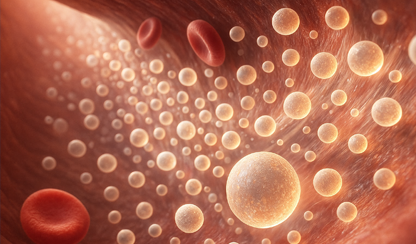29 November 2020
Media release
Lipids show promise for diagnosing and understanding Alzheimer’s disease
Lipids — fats in the blood — that are helping us to understand the metabolic changes associated with Alzheimer’s disease could also be used as markers to identify people at high risk of the disease and may provide a therapeutic pathway to prevention, according to a new study by Australian researchers.
This study, one of the most comprehensive of its kind, puts the spotlight on lipids, providing a holistic picture of how changes in the levels of these small, complex molecules are linked with the onset and development of Alzheimer’s disease.
This insight into what is happening at the molecular level by researchers at the Baker Heart and Diabetes Institute is welcome news given that global rates of Alzheimer’s disease are expected to reach 81 million by 2040 and there is a significant unmet need around risk assessment, diagnosis, prevention and treatment.
Institute researchers, in collaboration with researchers from Edith Cowan University and the Alzheimer’s Disease Metabolomics Consortium in the US, performed one of the most comprehensive lipidomic analysis of Alzheimer’s disease examining 5733 clinical samples from 1912 individuals in two large independent studies: The Australian Imaging, Biomarkers and Lifestyle flagship study of ageing and the Alzheimer’s Disease Neuroimaging Initiative study in the US.
Using advanced lipidomics technology developed by Dr Kevin Huynh at the Baker Institute, the team was able to demonstrate in Nature Communications how it is now feasible for researchers to examine in detail the comprehensive plasma lipidome in a human population to better understand how our metabolism is altered in Alzheimer’s disease.
Head of Metabolomics and co-author of the study, Professor Peter Meikle, says the Institute had recently expanded its lipidomic platform to better characterise lipid species, enabling researchers to measure hundreds of lipids in the blood and to analyse if and how they contribute to various types of disease.
Professor Meikle says evidence that lipids are involved in Alzheimer’s disease has been demonstrated by alterations observed in several classes of lipids in both the blood and brain.
“What’s important about this study is that we demonstrate the potential of plasma lipids as important markers to improve the risk assessment and diagnosis of Alzheimer’s disease and to better understand the metabolic changes occurring within this disease,” he says. “We may be able to intervene in some of these changes to provide some protection against or treatment of Alzheimer’s disease.”
Furthermore, he says our recent large-scale genome-wide association meta-analysis has identified many novel genes involved in lipid metabolism, some of which are also risk factors for Alzheimer’s disease. These will also help to target specific metabolic pathways for the prevention and treatment of this disease.
Alzheimer’s disease is a neurodegenerative disease characterised by progressive decline in cognitive function, usually presenting with memory loss. In the sporadic form of this disease, symptoms usually begin to manifest after the age of 65.
Professor Meikle said the failure of many Alzheimer’s disease clinical trials over recent years has highlighted the need for new approaches in this area.
“It is now recognised that changes in our metabolism are involved in the development of this disease, and we need to understand what is happening at a molecular level.”
The next stage of this work will be to test our biomarkers in independent population studies to provide risk assessment and early detection, and to develop appropriate interventions to maintain a healthy metabolism as we age and so reduce the risk of developing Alzheimer’s disease.
For further information or to organise interviews please contact:
Tracey Ellis
T: 03 8532 1514
M: 0433 781 972
E: tracey.ellis@baker.edu.au





